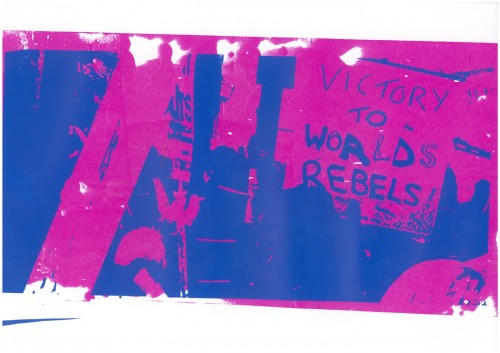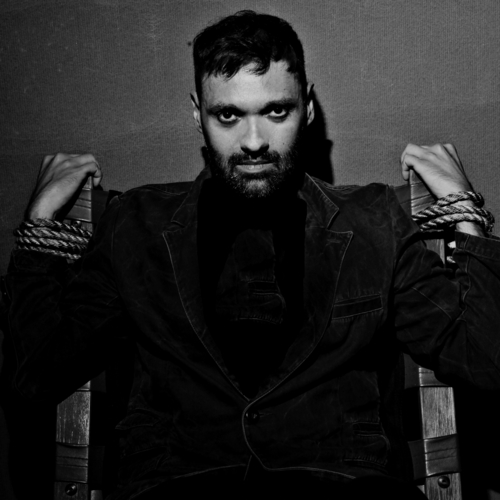Eyeliner Techno, QueerAcid, & Arpeggio fetishist // Berlin
ELECTROSEXUAL CHEMITRY Interview by Paul Davies
The method and the formula behind the sonic experiments of Romain Frequency
********
Electrosexual, a self-confessed synth and analogue fetishist, has released Art Support Machine, an album which bubbles over, with a mechanical yet unorthodox froth of forgotten sounds.
More Global Hypercolour than High Definition, the thirteen songs recall a time when there was still much to discover within electronic music with now-established genres still in their infancy. With refreshingly imperfect rhythms and arpeggios Art Support Machine successfully challenges the over-produced sonic landscape our ears are accustomed to yet still retains a familiarity.
With such an emphasis on nostalgia, it seems natural that the album should have been recorded in a bunker in Berlin, a city rich in musical and cultural history, and a key influence on a lot of the important electronic albums of the 70s and 80s. The topic of the studio is where we begin to get more of an insight into the world of Romain Frequency, the person behind Electrosexual...
Paul Davies: First of all, thank you for spending the time to talk to us in what has already been a busy year. Please talk us through your studio set up.
Romain Frequency: My studio is focusing on the connection between the synthesizers, effects units and the final recorder. I mainly use audio as opposed to midi. When I produce music I need every machine to be plugged in ready to be used. Even though I always have a sound idea in mind, I never know what I’ll start with and I let the instrument dictate the direction. Then starts the cooking!
The studio is a wonderful strange place. It is a like a blank canvas and I am always excited translating emotions into music.
I have been moving a lot over the past months, and my studio is following me. It is a mobile studio.
The album Art Support Machine lists a large and enviable number of synths and hardware. Have they travelled with you? Do you own them all?
Yes I own most of the equipment used on the album, although a couple of synths, like the Oberheim Matrix 6 and Elka Rhapsody belong to my friend and label partner living in Toulouse: François Remigi who co-produced the song “Out of Place”.
I could not live without my synths, so they travelled with me. This requires a lot of discipline and organisation.
I am not mentioning that the family is growing all the time!
It is funny that you mention family. Like a parent with several children you probably cannot pick a favourite, but you must have a favourite synth surely?
My favourite synth is the Korg MS20 mainly because it is a sound factory that has a lot of energy and can be very experimental.
For me, it is not a synthesizer, more like a magic box for emotion. Many of its sounds are really evocative and inspiring. It is very organic. The variety of sounds seems infinite. You can create drum sounds, soundscapes, noises, pads, or simply try to imitate sounds of traditional instruments like flute, oboe or guitar. Like the Roland’s TB303 was originally supposed to replace a bass (and failed), the MS20 was supposed to recreate any existing instrument sounds from an orchestra! that 70´s electronic utopia!
And is there a particular synth, past or present, you wish you owned?
For a long time I wanted to own a MOOG Liberation especially for my gigs. It is a wonderful and powerful Keytar synthesizer (made famous by Herbie Hancock) but when I got the chance to try one, I actually realized it was far too heavy for stage use, despite the fantastic sound quality.
You have released several songs and remixes before this year. Why did you wait before focusing on an album? What is a typical process when you are creating songs?
New music always sets the tone of where my head is at.
With a single song, the time between the creation and the release is usually quite fast which means it can easily follow the stream of my mood, feeding the track with a specific idea close to what I am experiencing at the present moment in my life.
Working on a full length album is a different process. It is a lot longer and more organised in the sense of a complete concept. You have to visualise the whole concept at once. A lot of the creative part and spontaneous work is being done beforehand, and then when the main demos are crafted it’s more a question of production, arrangement and then mixing and so on.
You have guest vocalists on several songs on the album. How much do they contribute to the songs?
I like the idea of collaboration on a song, because of its dynamic.
Generally, I start with the idea of the song, providing the music, title and theme direction, then the collaboration starts, turning the original project into a far more developed one or turning into a totally new idea.
Everyone will interpret the themes of your album in their own way but what were you trying to achieve?
I am fascinated about the mythology surrounding music and machines. I needed to explore this theme to be able to go further in the future. It was important for me to consider the machine as a persona independently from the human, with its own fear, emotion and sensitivity.
Did anything in particular inspire you to be fascinated by the theme of machines? A novel, film or other music perhaps?
There is a lot to mention: from the robots of Kraftwerk; the replicants of the movie Blade Runner; the synthetic artificial music performers from Norman Spinrad’s 1987 novel Rock Machine (aka Little Heroes) which I named my Record Label after.
Do you think you will continue to explore this theme of music and machines....like a follow-up or sequel? Or have you already got other plans for your next releases?
I still have a lot of ideas around Machines that I want to express in the next single releases out of Art Support Machine. The concept will develop on future videos from the album.
The new single “Automatic People” featuring vocals from Hanin Elias deals with the automatic life of the everyday routine and how and why you should get over it.
Future projects will focus on different themes obviously.
While the music is very important, tell us how important visuals are for Electrosexual either as promotional video or in a live setting.
Ever since the beginning, visuals have been part of the project: I developed a specific visual for each song or release.
For the live show, the visuals are used of course for their aestheticism and complement the music, but also to deepen the meaning of instrumental tracks (for example some visuals show definitions of specific terms as A.S.F.R. (alternative sex robot fetishes) on the song Fetish ASFR, or even political statements.)
With Art Support Machine, the concept is different - I teamed with two visual artists living in Berlin that inspire me a lot. They are Lukas Julius Keijser, who is working on this project exclusively with the silk-screening process and Philip Marshall who is the resident designer of the ZTT re-editions.
I use the different formats of the release as a canvas. Every format for the album (Vinyl Picture Disc, Digital and CD) shows a variation of the main visual.
Every single from the album will also have a dedicated artwork as they are a part of this concept.
At the end of the project, the ensemble will show all the prints created. Like in an art gallery.
What else can the audience expect at one of your live shows?
Each show is a performance. I use screens to project videos. As I am alone on stage, most of the tracks are adapted and remixed for the show so that I can perform live as much music and vocals as possible. Depending on where I am playing, I have a couple of synths or more on stage, as well as a drum/sample pad and effect controller and of course a microphone. In the end I want the audience to experience the performance as if there was a full band playing in front of them.
Who are your main influences? Who inspired you to try electronic music?
I always have been inspired by electronic musicians. As far as I can remember, Jean Michel Jarre was my first introduction to the genre. As a kid, I really got into Synth pop and New Wave with bands like Depeche Mode, Soft Cell or Talk Talk as well as early 80‘s electronic funk, the exciting pop of Trevor Horn & ZTT and the production of William Orbit. When Techno and Acid house came to my ears I started to imagine creating music myself, but it wasn’t until I moved to Montreal in 2002 that I actually did! I bought my first synth from Xavier Paradis of the band Automelodi (Echo Kitty at the time) and used my exile as stimulation. I realised I could do anything with the sound and it became an exciting story.
I could describe your music as techno or disco. You have just mentioned acid house and synth pop influences. Do genres mean anything in electronic music anymore? Are they important? Would you say that 'electrosexual' itself is a movement that you have created?
I like blending genres together and I couldn’t stick to one single direction. It is again about the emotion diktat, not about the style. Unfortunately, you have to put a name on your music. That’s why I like sometimes to invent new terms.
I created Electrosexual in reference to surrealistic non "(human) sexuality". It started as a statement, considering machines and synthesizers as genitors, having their own kind of sexuality.
This concept follows a movement inspired by artists including David Cronenberg, H.R. Giger, Psychic TV, Add N to (X) and Chris&Cosey/Throbbing Gristle.
In the world of electronic music, the pioneers often end up falling behind. Do you hope to keep your music sounding fresh and if so how?
A song, when finished, is like a tattoo...it stays forever. My music is always very personal and singular, so in this way will always remain unique. I like to play with references and be inspired by my music background.
I don’t use any up to date piece of equipment so I don’t have the feeling to write fresh music.
I always try to keep the creative process as exciting as possible. I am not worried about the freshness of my sound, I am more worried of not having enough time to release all the music I have in my mind for the world to hear...and this is a wonderful motivation!
Interview by Paul Davies Published in FourCulture Magazine

